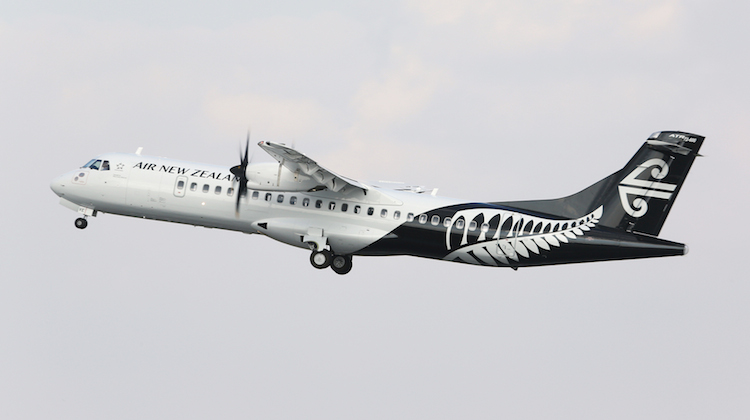Air New Zealand will become the world’s third largest ATR operator after placing a fresh order for 15 additional ATR 72-600 aircraft for delivery from late 2016.
Eleven aircraft are earmarked to replace the airline’s nine- to 15-year-old ATR 72-500 fleet, while the remaining four are to enable expansion within regional New Zealand, Air NZ said on Thursday.
The new aircraft are in addition to Air NZ’s existing ATR 72-600 order, which sees seven due for delivery between now and mid-2016.
Replacing the -500 series aircraft — which are very similar in passenger experience terms to the -600 apart from the slightly larger bins on the newer turboprops — will be an advantage for fleet commonality reasons, as well as the markedly upgraded avionics featured in the -600 models.
Air NZ’s Christchurch-based subsidiary Mount Cook Airline operates the aircraft on both regional routes and on some off-peak flights on the mainline trunk from Wellington to Christchurch. The slower speed of the ATR 72, compared with the similarly-sized Q400 turboprops from Bombardier, is not a marked disadvantage for the Star Alliance member given the small size of the country, the distance between regional hubs and regional airports, and the clearly attractive economics of one of the world’s most efficient aircraft.
“The extra four 68-seat ATR 72-600a that we are adding to our fleet will enable us to operate up to an additional 600,000 seats into the New Zealand regional market annually. This latest investment will further allow us to maintain our low fare price and high frequency leadership,” Air New Zealand chief executive Christopher Luxon said in a statement.
The reference to price and frequency would seem to point to the airline’s market positioning, defending itself against Jetstar’s inaugural regional turboprop services, which start in December.
Air NZ’s yield management is impressive, and by carefully walking the line between lead-in fare prices and availability windows, the airline may well be able to defend its pricing against frequent (and often valid) criticism from regional New Zealanders.
Frequency, however, is certainly a point in Air NZ’s favour, which will be important for the corporate market in New Zealand’s regions. Despite a 2015 average 15-minute departure time performance of just under 90 per cent, mainline Jetstar NZ still has a reputation for delays and cancellations, and the high utilisation of the low-cost carrier’s Airbus A320 fleet has proven a problem in the past. The issue for Jetstar in terms of passenger perception is not so much that many flights are delayed, but that when the schedule is affected the capacity to return to normal operations is less than Air NZ’s.
“Once these new aircraft arrive we will operate a fleet of 29 ATR aircraft, the third largest ATR fleet in the world, which is testament to the breadth and depth of our regional network,” Luxon said.
Given the airline’s focus in recent years on creating a young and efficient fleet, it is perhaps unsurprising that Air NZ is replacing these older ATR 72-500s. Yet while the airline’s 68-seater -500 fleet has an average age of 14.7 years, it is notable that the airline is replacing these aircraft before the slightly younger but arguably less economical 50-seat Bombardier Q300 turboprops (operated by Air Nelson, based at the eponymous South Island airport). Air NZ is also phasing out the 19-seater Beechcraft 1900D turboprops and ending services to three smaller regional airports.
Speaking to Australian Aviation in October, Air NZ’s chief sales and commercial officer Cam Wallace summed up the economics of the airline’s regional fleet plans: “We think the Q300s and the ATRs will be the core components of the regional fleet for the medium to long term. Our focus on new aircraft is the ATR 72-600, so generally speaking those are the new aircraft we are investing in. Between the ATR and the Q300 we think the ATR has better operating economics.”
In practical terms, however, the 109nm increase in range of the ATR 72-600 (825nm) over the -500 model (716 nm) is unlikely to make a significant difference to Air NZ, as this map drawing the two range circles from Auckland shows. (Map generated by the Great Circle Mapper at gcmap.com.) Yet if Air NZ did want to operate turboprop aircraft in strong Roaring Forties headwinds between, say, Auckland and Invercargill at the southern tip of the South Island, the additional range could prove useful.

Meanwhile, in other ATR news, the turboprop manufacturer has signed a 12-year global maintenance agreement with PNG Air, formerly Airlines PNG, that provides maintenance, repair and overhaul services for the airline’s ATR 72-600 fleet.
PNG Air has recently taken delivery of its first aircraft, with a further six to come over the next couple of years.
Read an in-depth analysis on the changing dynamics of New Zealand regional commercial aviation market in the November edition of Australian Aviation, on sale now.











